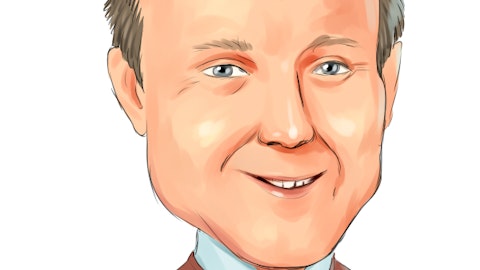Apple Inc. (NASDAQ:AAPL) investors are getting restless. Not only have the company’s competitive prospects come under fire in recent months as several fallen rivals mount turnarounds and frenemy Samsung continues to copy its way to success, but shareholders are also becoming increasingly agitated at Apple’s cash hoarding.
At the end of 2012, Apple Inc. (NASDAQ:AAPL) was sitting on $137.1 billion in cash and investments, which is more money than any rational company could conceivably need to fund operations and strategic initiatives. The most obvious solution to boost its dividend as well as its share repurchase program. However, that’s easier said than done, and Apple faces two unique challenges in doing so.

There are two primary ways that companies tend to approach dividend payout strategies. One is a constant payout ratio where a company pays out a set percentage of earnings every quarter. The problem with this approach is that earnings tend to be rather volatile due to seasonal factors and macroeconomic business trends, so investors long ago implicitly voted in favor of a longer-term approach of affordable payouts that they can rely on that steadily increase over time.
Changes in dividend payouts provide signals to investors regarding management’s confidence in the business over the long term, which is why significant dividend boosts or cuts can similarly spark a rally or sell-off. Just look at CenturyLink, Inc. (NYSE:CTL), which plunged by 23% earlier this month when it cut its quarterly dividend by 25% from $0.725 per share to $0.54 per share.
If Apple Inc. (NASDAQ:AAPL) were to significantly boost its dividend, then that sends a strong signal to investors that the business is rock solid. Apple Inc. (NASDAQ:AAPL) could easily afford to double its dividend, increasing its payout from $10 billion annually to $20 billion annually, without flinching. The challenge there is that doubling its dividend just a year after reinitiating it sets a hard precedent to keep up with.
Even if Apple were to make such an aggressive move, investors shouldn’t expect dividends to continue increasing at such an unsustainable rate, and Apple Inc. (NASDAQ:AAPL) would have to effectively convey that message that such a boost won’t happen every year.
One possible way to accomplish this could be in the form of a large one-time special dividend. For Apple, this could only be a temporary fix because at the rate that the company generates cash ($23.4 billion in operating cash flow last quarter alone), it would likely need to continue making large special dividends, which would almost make them a regular occurrence.
Stuck abroad
Since most of the cash is held by foreign subsidiaries and Apple needs some of its domestic cash for operational uses, it would either need to pay repatriation taxes to bring cash home or raise debt to fund dividends and buybacks.
Apple has long enjoyed a debt-free balance sheet, and the idea of raising debt to pay dividends or buy back shares sounds counterproductive. However, keep in mind that this isn’t as uncommon as investors might think — Microsoft Corporation (NASDAQ:MSFT), Dell Inc. (NASDAQ:DELL), and Cisco Systems, Inc. (NASDAQ:CSCO) have all done this in the past.
The way that such a move would be beneficial lies in reducing Apple’s overall cost of capital. A company’s capital structure usually includes debt and equity, and equity is more expensive than debt. For example, we can use the capital asset pricing model, or CAPM, as one method to estimate Apple’s cost of equity.

We can look up the inputs for all of these variables. For the risk-free rate, I’ll use the yield on the 10-year Treasury, which is currently 2.02%. Apple’s beta is currently 1.49, as it’s been rather volatile of late. Widely followed finance professor Aswath Damodaran at NYU’s Stern School of Business publishes estimates for the equity risk premium and pegs it at 5.67% (based on trailing-12-month cash yield) as of the beginning of this month.
Plugging all of those figures into the above equation puts Apple’s estimated cost of equity at 10.47%.
If you look at the current interest rate environment, which remains at historic lows, Apple would be able to borrow domestic cash for incredibly cheap. Fellow tech blue chip International Business Machines Corp. (NYSE:IBM) borrowed $1 billion just this month at a fixed rate of 1.25%, in addition to another $1 billion in floating rate notes.
The point is that Apple would be able to easily trade out expensive equity capital for cheaper debt capital by issuing debt at low rates and repurchasing shares where investors are demanding much higher returns.
What’s the largest tech company on Earth to do?
At this point, a modest dividend increase doesn’t seem like it will satisfy investors, and Apple may need to announce a big increase in its dividends and buybacks. How will it address these two challenges?
The article 2 Challenges Apple Faces With Boosting Its Dividend originally appeared on Fool.com and is written by Evan Niu, CFA.
Fool contributor Evan Niu, CFA, owns shares of Apple. The Motley Fool recommends Apple and Cisco Systems (NASDAQ:CSCO). The Motley Fool owns shares of Apple, International Business (NYSE:IBM) Machines, and Microsoft.
Copyright © 1995 – 2013 The Motley Fool, LLC. All rights reserved. The Motley Fool has a disclosure policy.





